 Choosing a microphone is a lot like choosing a pair of headphones; what may sound good to you may sound bad to the next person. Nevertheless, we thought a survey of microphones in use in radio production might help shoppers narrow down their choices a bit. The top five mics mentioned were: #1) the Electro Voice RE20, #2) the Neumann U87, #3) the Neumann TLM 193, #4) the Sennheiser MD-421, and #5) the Shure SM7.
Choosing a microphone is a lot like choosing a pair of headphones; what may sound good to you may sound bad to the next person. Nevertheless, we thought a survey of microphones in use in radio production might help shoppers narrow down their choices a bit. The top five mics mentioned were: #1) the Electro Voice RE20, #2) the Neumann U87, #3) the Neumann TLM 193, #4) the Sennheiser MD-421, and #5) the Shure SM7.
Q It Up: What is your favorite microphone for recording voice tracks in the studio, and what do you like about this mic?
Bumper Morgan <bump[at]Bumper Productions.com>: I love the “Russian Lomo” microphone. It’s a tube mic with a lot of balls.
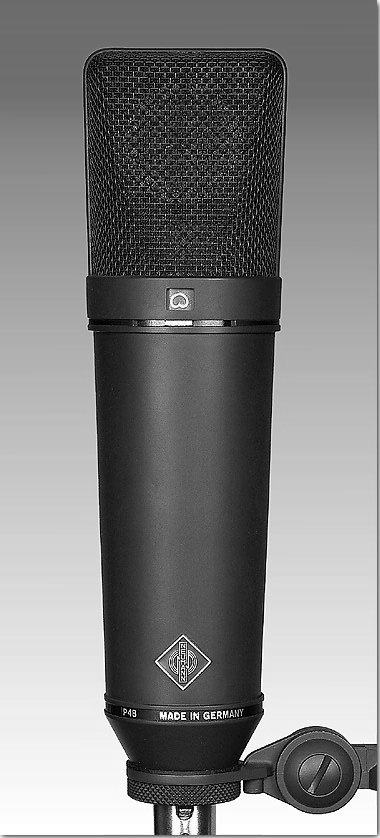 John Peace, Audio Production Experts <John[at]aperadiotv.com>: I’ve found the Neumann U87 to be a great mic when you desire a “close, intimate” presence in the spot. It tends to pick up the most subtle voice inflections and really can bring a certain warmth to the presentation. For those “Hi Energy” car campaigns which we do so much of the time, the Electro Voice RE 20 is the choice. It handles the peaks well, without picking up all the huffing and puffing that goes along with the screamer type delivery. Studio guests are mic’d with our trusty Sennheiser 421-U5. Hey if it was good enough for Johnny Carson’s guests, it’s good enough for ours. This mic works well especially for the “mic shy.” You can really stick it right in the face of those which do not project their voice well, without getting a lot of noise.
John Peace, Audio Production Experts <John[at]aperadiotv.com>: I’ve found the Neumann U87 to be a great mic when you desire a “close, intimate” presence in the spot. It tends to pick up the most subtle voice inflections and really can bring a certain warmth to the presentation. For those “Hi Energy” car campaigns which we do so much of the time, the Electro Voice RE 20 is the choice. It handles the peaks well, without picking up all the huffing and puffing that goes along with the screamer type delivery. Studio guests are mic’d with our trusty Sennheiser 421-U5. Hey if it was good enough for Johnny Carson’s guests, it’s good enough for ours. This mic works well especially for the “mic shy.” You can really stick it right in the face of those which do not project their voice well, without getting a lot of noise.
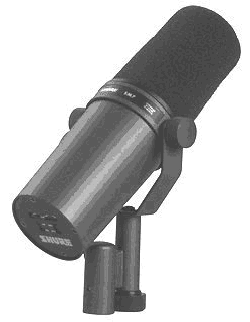 Jack Shaw <jshaw[at]execpc.com>: I use a Shure SM-7. I got used to it when I was on the air. It was within my price range. If I could afford a Neumann, I would get it. I also have an old Shure Unidyne (looks like the robots in Battle Star Galactica) that I use from time to time for a little different sound.
Jack Shaw <jshaw[at]execpc.com>: I use a Shure SM-7. I got used to it when I was on the air. It was within my price range. If I could afford a Neumann, I would get it. I also have an old Shure Unidyne (looks like the robots in Battle Star Galactica) that I use from time to time for a little different sound.
Richard Stroobant, CJAY 92FM, Calgary, Alberta, Canada <bigdick[at]cjay92.com>: My favorite mic for voice work is the Neumann U87 followed closely by the Neumann U89. They are expensive, but in my opinion provide the best sound. I’ve also found that in shock mounts, they are pretty durable. We are lucky enough to have ONLY Neumann mics in the station and don’t have to send them out for repairs very often.
John Pellegrini, <John.Pellegrini [at]abc.com>: I don’t have a favorite microphone because every one has a different tonal aspect that can be exploited properly for character voices and ambiance. I’ve never liked the idea of “one microphone is best” that some engineers subscribe to, because I like a wide variety of sound potential. In my studio currently, I have an Electro-Voice RE-20 (a good basic mike sound), and a Sennheiser MD 421, which I like for its adjustable tone feature. Ultimately, I’d like to add a Sennheiser MKH 416 shotgun mike (great for “street” sound), and a Neumann (but then again wouldn’t we all).
A few years ago, Stereophile Magazine (not to be confused with Stereo Review) put out an audio reference CD for their subscribers. On that disc was a track recorded by J. Gordon Holt, the founder of the magazine, reading an article he wrote on the subject of diversity of sound reproduction in the audio world. But what made the cut really interesting was that he recorded separate lines of the article on different studio microphones (approximately 30 or so different ones). You wouldn’t believe the differences in sound quality on these mikes! I am told by Jon Iverson of Stereophile that this CD can be ordered from their website at www.stereophile.com (or www.guidetohometheater.com or www.hifishow.com). It’s worth the listen, especially if you’re considering microphones for your own studios, and you’d like a cheap way to demo lots of them.
Dave Foxx, Z100 Radio, New York <foxx[at]z100.com>: At the risk of sounding a bit snobbish, I am an audio purist, at least when it comes to laying down voice tracks. If that mic is NOT what is being used on the air, so much the better. I want the station imaging work to really jump out of the radio. That’s why, after much begging and pleading with the bean counters, I got myself a Neumann M-149. Expensive? Yes (a little under 5 grand). Worth it? Every penny. There’s NO coloration, regardless of proximity. It delivers as smooth and complete a signal as anyone could hope for. With multiple pickup patterns (which, by the way, are EXACTLY what they’re supposed to be, whether you want super-cardioid, butterfly, or omni) and built in filtering that really works, this mic really makes my work easy.
But the microphone is only half of the voice track equation. The microphone pre-amp is every bit as important. This becomes clearly evident when you are using a really good mic. For a long time I used a Shure SM-7 running through the Auditronics 110 console built-in pre-amps, and I thought it sounded pretty good. When I got the Neumann, I realized just how crappy sounding the mic-pre really was. So, I went out and got the Studer D-19 dual in/out mic-pre. What an amazing difference! A brilliant high end without sounding brittle, a bottom end that doesn’t get mushy, and a LOT of control make this mic-pre worth twice what they charge (about 6 grand when I got it). Now I’ve gone so far as to get the Studer for my home studios. (But I haven’t saved up enough to get the M-149. I’m still using the SM-7.) When the SM-7s are pumped through the D-19, I get an amazingly better sounding signal. In audio pro demos I’ve done for ProTools, using tracks I generated at home, I’ve always had several questions from people who work in some of the best studios in New York regarding the voice tracks and the mic chain, with big compliments to the sound. The bottom line is, the better the input signal, the more you can do with it, without making it unintelligible. THAT makes my job a LOT easier. We like that.
Chris Speda <speda[at]stuttgart. netsurf.de>: For years I worked with the Neumann TLM 170. Great mic. A couple of months ago I checked the Brauner VM1. Brauner is a German guy who built this mic on his own (he told me). I really couldn’t believe what I heard. Very transparent and absolutely crisp. In comparison to the TLM 170, there are “worlds” between them. Imagine using a mic with a thick curtain in front of it. That’s my impression of the TLM 170 compared to the Brauner VM1. It’s not just a little; you will really hear it. By the way. The VM1 in Germany costs about 5000 DM. (That’s about $2,800). I didn’t buy it because I get 90% of my voices via online transmission with the MusicTaxi or APT-X. To me it makes no sense to spend this money. Another really good mic is the Sennheiser MD 321 (legendary). It makes male voices really huge. I often use the MD 321 instead the TLM 170. Getting a good voice sound to me is not done by getting the mic that costs the most money. It’s the way the talent works with it. If he can’t kiss the voice screen, he’s too far from a good sound.
Ty Ford <tford[at]jagunet.com>: TLM 103. It’s very loud (has a high output). It’s very quiet (has low self noise). Whereas most good condensers let you hear the bearings in the cart machines, the TLM 103 allows you to measure the viscosity of the oil on the bearings in the cart machines.
Jay Andrews, <jayandrewsproductions [at]juno.com>: My preferred studio microphone is, believe it or not, a Western Electric 639B ribbon-type. Reasons: 1) it has lots of range and is the only mike I’ve ever used that truly captures my whole voice. 2) no added EQ or compression needed while recording. I mean NONE. This mike has a very balanced tone that’s incredibly rich and full. 3) the mike sounds very different in each of its modes, making it extremely useful for endless vocal effects. Second favorite? My good old Sennheiser 421; it just won’t break and sounds great.
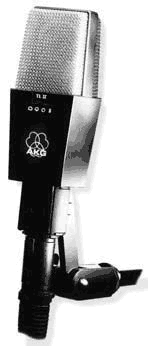 J.P. Shane, <JPSHANEO[at]aol.com>: What mic is my favorite for VO? Good question. I put some true thought to it and have come to realize that “I’m one clingy-ass, obsessive, overprotective microphone OWNER! …There are three microphone’s I own that I use all the time and couldn’t live without. The old AKG C414 is one of the only microphones I know of that truly offers the level of versatility it brings to the table. I also own a U87—also great at several ends of the room. The mic I use for my voice is a Sennheiser MKH 416 P48. It’s not a great mic for females, nor is it very adjustable for the untrained voice. But if your voice is at all in the weeds, and your mic processor’s release time is fast enough to bounce back from some guy sucking up on a shotgun mic (like the Valley 401), it’s a combo that a ton of voice-over guys have been with for a long time. I like the sound I get from that setup.
J.P. Shane, <JPSHANEO[at]aol.com>: What mic is my favorite for VO? Good question. I put some true thought to it and have come to realize that “I’m one clingy-ass, obsessive, overprotective microphone OWNER! …There are three microphone’s I own that I use all the time and couldn’t live without. The old AKG C414 is one of the only microphones I know of that truly offers the level of versatility it brings to the table. I also own a U87—also great at several ends of the room. The mic I use for my voice is a Sennheiser MKH 416 P48. It’s not a great mic for females, nor is it very adjustable for the untrained voice. But if your voice is at all in the weeds, and your mic processor’s release time is fast enough to bounce back from some guy sucking up on a shotgun mic (like the Valley 401), it’s a combo that a ton of voice-over guys have been with for a long time. I like the sound I get from that setup.
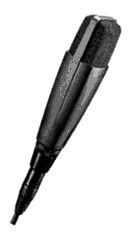 Craig Rogers, WHO/KMXD/KYSY, Des Moines, Iowa, <crogers [at]jacor.com>: I used to use a Sennheiser MD421 on the “M” setting because I liked the crispness it provided. I’m not a “big voice,” so I wanted to emphasize the midrange where my voice lies. I also liked the preset roll-offs, which made it easy to dial in a quick thin sound if needed. I switched to the ElectroVoice RE27 when our engineer brought one back from NAB a few years ago. Still had that crispness, but also brought out the lower resonance I do have without making things muddy. It also has several roll-off/boost options which I like.
Craig Rogers, WHO/KMXD/KYSY, Des Moines, Iowa, <crogers [at]jacor.com>: I used to use a Sennheiser MD421 on the “M” setting because I liked the crispness it provided. I’m not a “big voice,” so I wanted to emphasize the midrange where my voice lies. I also liked the preset roll-offs, which made it easy to dial in a quick thin sound if needed. I switched to the ElectroVoice RE27 when our engineer brought one back from NAB a few years ago. Still had that crispness, but also brought out the lower resonance I do have without making things muddy. It also has several roll-off/boost options which I like.
Johnny George, Johnny George Voiceovers, Indianapolis, Indiana, <HOTAUDIO[at]aol.com>: In my HotSpots! Studio I use the AKG 414B (retails at about $1000+, depending on who ya know). It’s normalled thru my Aphex Expressor 651. Settings to give it that upper mid-ranged kick, that I prefer, include the following: threshold -10, ratio 5, attack 10 ms, release time .06 sec, HFX ratio 7, frequency 6.4 kHz. The final inline signal I have routed through my Alesis dual 1/3 octave EQ with a little bottom kick at 80, mid boost at 2K and a little bite at 8K without having to worry about a de-esser. I’ve been very happy with this mic for the past 6 years and also use a CAD Equitek E-100 as my utility microphone. (That’s their basic mic that will run you about $500. Prices may vary. See dealer for details. Member FDIC.)
Mike Carta <kcarta[at]supersweep ers.com>: I use the Neumann TLM-193 mic. It’s very responsive and sounds great! I had been using an AKG-3000 condenser which I thought sounded pretty good until I plugged in the Neumann. I’m very pleased with the TLM-193.
Tim Mikkels <gunnpro[at]earthlink .net>: For a straightforward, honest, and true sound, the EV RE20 can’t be beat. I use the RE20 most of the time. I like it because it’s clear, crisp, and in my opinion, best duplicates the natural sounding voice.
Dennis Coleman, Infinity Broadcasting - Austin, <denman[at]swbell.net>: We use two Rode NT2 mics in our main studio, but Electro Voice stuff in the other rooms. I like the Rodes because they give us the warmth of the Neumanns for a fraction of the cost. The jocks took a while to get used to them though, since you don’t have to get right up on one to make it sound great.
Andy Capp, Impact Audio Creations, <andycap[at]dtgnet.com>: Ahh, one of those gear-head questions that I have a seriously biased opinion about! The experience that brought me the closest to complete audio nirvana was a voice-over session I did in a studio equipped with a Neumann U87, fed through a Focusrite Red pre. My God, I almost sounded like a real voice-over performer! Actually, I’m convinced that in the right hands, that combination could record the raunchiest bodily function and make it come out as a Mozart symphony.
I do believe that mics are indeed a matter of the voice being recorded. I’ve heard some incredible VOs done over a Shure SM-57, which costs a few coins less than the shock mount for a Neumann. The trick is finding “your” mic, and that means experimentation. Despite what many radio engineers may think, there is no Mythical Swiss Army Mic that can be all things to all voices.
Just as important is the choice of a mic pre-amp. I’ve heard the tone of some wonderful mics destroyed by the wrong pre, whether it was a cheap piece of garbage, or simply set up improperly. I cannot stress it enough: getting the “right sound” means experimenting with many mics and pre-amps, in different combinations. You’ll drive your dealer nuts, but it’s your voice-over quality that you are investing in.
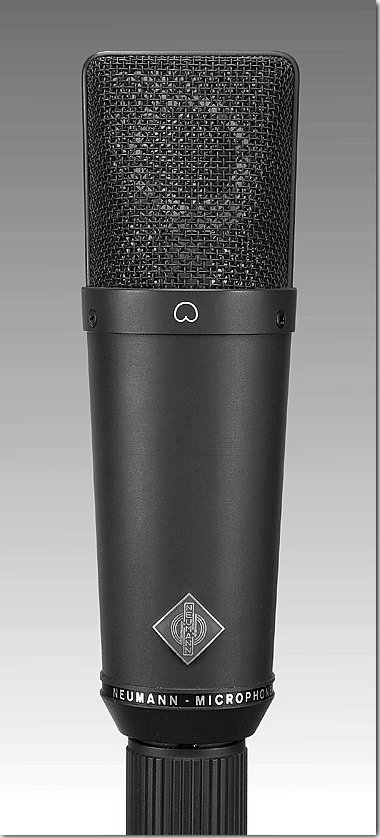 Ron Schriek, Profisound Audio Design,<info[at]profisound.nl>: Here at Profisound AD in Holland we tried a lot of microphones. For normal use in commercials (male/female) voices I like to work with the Neumann TLM 193. Why? Just because the sound is fresh and neutral. For close-mike “warm” male voices, we use the Neumann M149 Tube Microphone. The warmth is great, but the presence of this mic is a bit too “coloured” for normal use.
Ron Schriek, Profisound Audio Design,<info[at]profisound.nl>: Here at Profisound AD in Holland we tried a lot of microphones. For normal use in commercials (male/female) voices I like to work with the Neumann TLM 193. Why? Just because the sound is fresh and neutral. For close-mike “warm” male voices, we use the Neumann M149 Tube Microphone. The warmth is great, but the presence of this mic is a bit too “coloured” for normal use.
Craig Jackman, CHEZ 106.1-FM, Ottawa, Ontario, Canada, <craigj[at]canada.com>: At CHEZ we have a decent selection of mics to choose from. The best ones that we have on hand are the Beyerdynamic MC-740 large diaphragm condensers, on the cardioid or hyper-cardioid pattern. They get the most use as they are the most neutral on the most voices and are relatively immune to the affects of temperature and humidity. Good announcers can really work the proximity effect on these in a very positive way. All our mics are set to cardioid. It is very rare when we will use a mic set to omni or figure-8. For my voice, I use a Microtech-Geffal PM-860 that makes me sound great, but seems to make everybody else sound shrill.
In helping a friend set up a home voice-over studio, I got the chance to test a whole lot of new mics in my studio against what we normally use. The AKG Solid Tube mic was my favorite with absolutely incredible warmth and presence—a really special sound I thought that was priced really well. She ended up buying the Rode NT-2, which I thought sounded fine—very even. We tested the new Neumann TLM-103, which surprised us all at how bad it was—definitely the worst of the bunch.
Scott Taylor, Providence Media Group, <ProvMedia[at]aol.com>: We’ve all worked with a variety of mics from Electro-voice, Sennheiser and Shure, but the award goes to the RE20.
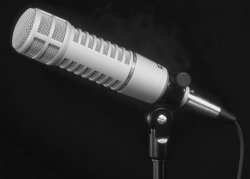 Don Lawler, Target Marketing, <GoodSpots[at]aol.com>: I prefer the RE-20. It’s a workhorse—rugged and has a nice smooth response and sound. I call it the “poor man’s Neumann” mic.
Don Lawler, Target Marketing, <GoodSpots[at]aol.com>: I prefer the RE-20. It’s a workhorse—rugged and has a nice smooth response and sound. I call it the “poor man’s Neumann” mic.
Dean Tyler, Voice & Vision Productions, Ft. Myers, Florida, <Deansvoice[at]aol.com>: Well, I am an equipment junkie, so I have a few I like and use. The two I use most often are a Sennheiser MD 421-U5 and an AKG C3000. No technical reason why, I just like the way my voice works with those two when I run them through a Valley 400 processor. I also use an AT-RE-20. It gives me a nice clear sound with a crisp high end. I just recently bought a Rode NT-1, and for the price, found it to sound very big and full. But I am still learning to work with it and running it through a couple different processors to determine the best set-up for it. A fellow VO guy named Steve Wood swears by his AKG 414, so down the line, I am anxious to try that one too!
Stew Herrera, KLOS-FM, <stew[at]earthlink.net>: About a year ago I bought a new mic from Soundelux here in LA. It’s a big cardioid pattern FET mic called the UI95. It ran me about $1200, and I use it almost exclusively for everyday stuff. It has the standard controls you’d expect to find—20db pad and a low cut filter. It also has a switch for “fat” operation, which means it enhances bass response. I don’t use that setting much for everyday vocal tracks, but when I need to record music, it’s a cool option to have. There are RE-20s lying around everywhere, and if I’m doing two voices in a dialog, I’ll use one of those just to color the other voice—saves time in trying to tweak. To tell the truth, I’m not really all that worried about the microphones I use, so long as they meet some professional standard. In a “real” recording studio, where they cut albums, you’ll find guys choosing mics from among dozens of models. But in radio, it’s usually just a mic or two. We in radio don’t usually have the budget for a bunch of mics, the time to go sifting through them, or the need to. So hopefully, you have at least one good mic to use as your main workhorse. The RE20s are everywhere. So are Sennheiser 421s, and Shure SM7s, and they’re all good mics. Our main studios are outfitted with Neumann TLM 193s. I should probably give one of those a try and see how it compares to the UI95, but the differences will probably be pretty subtle. At this point, I’d be a little bummed if I had to go back to an RE20 or a 421 as my main mic because I can definitely hear the difference. I’ve been spoiled. The fact is, most stations make due with dynamic mics. EQ, compression, and processing can make up for some of the difference, but at the end of the day, a well written piece of copy cut through a Radio Shack mic will always sound better than hack copy cut on a solid gold mic anyway.
Andy Frame, <aframe[at]usa comp uters.net>: Never got a choice! I’ve used either the company supplied black Sennheiser with the bass-boost collar, an Electro-voice RE-20, or one of many of the Shure or Electro Voice “generic” mics. I do get a chance to use a Sennheiser shotgun when doing v/o for video, and it makes me sound very nice. It offers a very true representation of my normal speaking voice, and with a gentle gate and compression, there is no “inhale” noise. It also lets me get into my voice acting, because I know as long as I stay within so many degrees of the axis, I can get as loud or soft as I’d like. On the flip, I like the ability to massage the bass proximity effect with the RE-20 and use it (with tweaked companding) for nifty vocal fx.
Dave Obergoenner, <daveo[at]mvp .net>: The Neumann U-87, but only because no one in radio can afford a U-67 anymore. The U-87 is the closest thing to an ear we can afford! On a tighter (still) budget, the new Shure KSM-32 condenser sounds similar, but not quite as good.
Dennis Daniel, Topline, Ronkonkoma, New York, <TOTTDenny[at]aol.com>: No question about it, the RE-20! Ever since I first saw this giant behemoth of a mic, I was amazed by the resonance it gave my voice. It cradles your vocal vibrations and gives you that booming GOD-like sound. It’s also great for those times when two people have to be on the same mic. And hey, it looks cool as hell! What mic do you always see in photos of radio station personalities? The good ol’ RE-20.
Donnie Marion, 104 KRBE, Houston, Texas, <dmarion[at]urjet.net>: We use Audio Technica AT4033s in all our production studios. We’ve used them for about 5 years and have liked the sound enough to not look around for anything else. When we first demo’d the AT4033, we noticed it handled “loud voiced DJs” better than the mic we had (meaning we didn’t have to turn down the input to the Symetrix). The old mics were Shure ( I think SM-7s & SM-5s). There was one guy who sounded fried even when he wasn’t anywhere near max’d out. We figured if it can make him sound clean, we need to keep it. That’s pretty much been my experience. When I go to other studios for voice work, I usually don’t like the sound of those mics as much as my studio here at work, but I don’t notice what mic is being used either.
Bryan Young, Zimmer Creative Services, Cape Girardeau, Missouri, <bryany[at]mvp.net>: That’s a good question. We have three choices in our main production facility: an EV RE20, a Neumann U87, and most recently, Shure’s new KSM32. A lot depends upon the application. It seems the jocks like a microphone that really punches—in an attempt to make their voice bigger than it actually is (EV RE20). As a writer/producer that is looking for tools to help convey the full spectrum of vocal emotions, I prefer the Neumann. It’s ideal for picking up subtle sounds like the airiness of a whisper or a sigh. I recently took the new Shure KSM 32 (studio condenser) on a test drive. It is almost as close to an “ear” as the Neumann, but lacks somewhat in the upper mid-range. However, the Shure KSM 32 is a fraction of the cost of the Neumann and may be an affordable way to get close to that sound.
Kurt Schenk, Jacor Rochester, <PookProduk[at]aol.com>: I really like the sound of the AKG-H17A. I love the fullness it adds to my otherwise “tenor” voice. I’ve put no windscreen on it. We did at one point, and it really cut back on the base qualities of the voice. I just had to learn how to cozy up to it, and I love it. We’ve had that mic here at WHAM/WVOR for 15 years. I think that says a lot.

